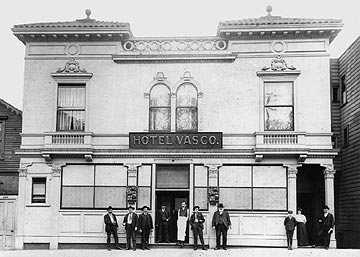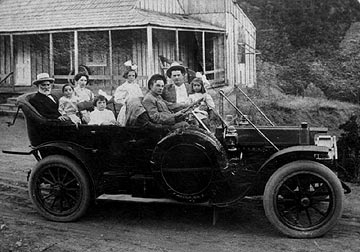Early Basques in California
 Gloria
TotoricagŁena, Center for Basque Studies University of Nevada, Reno
Gloria
TotoricagŁena, Center for Basque Studies University of Nevada, Reno
Large scale Basque emigration toward the United States has ceased, and those few new immigrants now entering the country are generally graduate students or well-educated professionals with artistic skills and/or corporate connections for employment. They leave a Basque Country which forms parts of freely elected autonomous governments or departments, and a European Union with relative economic stability.
This was not always the case, and in fact, initial Basque emigrants to the United States from the mid 1800s and the beginning of the 1900s escaped what could be described as almost the opposite circumstances. Following the two Carlist Wars, 1833-39 and 1872-76, with economic stagnation, production decline and political upheaval throughout, Basques experienced many circumstances pushing them out of their homelands. Access to information networks concerning possible economic opportunities and assistance was abundant. Emigration out of the Basque Country was nothing new and was quite a common option. What were indeed new factors in the 1850s were the discovery of gold and silver in California, Nevada, Oregon and Idaho, and the possibility to move west across the United States by rail instead of traveling by boat around the South American continent. The completion and connection of the Transcontinental Railroad in 1869 facilitated the movement of people across the territories to California, where public lands were utilized free of charge for animal grazing, and where populating the towns was a priority.
The Industrial Revolution of the nineteenth century disrupted traditional agricultural economic activities in Europe and it displaced workers from both rural and urban areas. The cheaper manufacture of products left Basque artisans searching for markets -which waited open armed in the Americas. Though it may have provided new jobs for existing urban Basques, it simultaneously displaced many as floods of migrants from other regions of Spain made their way to the more industrialized Basque Country in Bizkaia and Gipuzkoa seeking employment. Basques had to compete with this cheaper labor in their home territory.
 |
| Hotel vasco. Bernardo Altube. |
The first Basques to migrate to today’s California did so after initially emigrating to Argentina and Chile, and they traveled from South America to California in the search for gold. However, although not all of the miners would find valuable minerals, they did need to eat everyday, and the agricultural business of producing foodstuffs grew tremendously. There were established Basques who had migrated to the area earlier while under Spanish and Mexican control such as Dominique Oxarat, Domingo Amestoy, Antonio Jauregi and Miguel Leonis, who were known cattle barons in the Calabasas and Los Angeles region. Basque immigrants may have attempted their luck in the rush for gold, but they soon turned their attention to raising cattle, and later to raising sheep, dairying, hotels and boarding houses, and to farming and gardening. Brothers Pedro and Bernardo Altube (who had emigrated from Oñati, Gipuzkoa to Argentina, and from Argentina to California in the 1850s) became livestock barons of cattle when in 1873 they created their Spanish Ranch in Independence Valley, Nevada near Elko. In 2004, it still remains one of the largest ranches in the entire United States. Several other Basques who had arrived in the California San Joaquin Valley also moved their livestock herds east to New Mexico and Arizona, and northeast into Nevada. Once the railroad connected the East Coast to the West Coast, the safer, faster and cheaper travel enabled many more Basques to immigrate directly to the western United States after crossing the Pacific and landing in New York. Men began to send for their sons, brothers, and cousins and then their wives, daughters and sisters.
Basques were already spread throughout the southwestern United States as a result of the Spanish colonization of lands making up what was formerly Mexico. They were considered “Mexicans” before the land was ceded to the United States, and for generations had lived in the areas of California, Arizona, and New Mexico. Researching Basque surnames, we find several Basques that were working as gardeners in the Dolores Missions of California as early as 1849, and when reading the marriage rights certificates of the Catholic Churches, we see numerous weddings between Basques at this same time period.
The first recorded Basque hotel in the United States was constructed after the 1849 California Gold Rush, in San Francisco, on Powell Street, in 1866 by Juan Miguel Aguirre. Aguirre also established the first fronton, or handball court, in California. The Yparraguirre family then built the Basque Hotel and fronton in the 1880s, and soon after other Basque hotels appeared such as the Hotel France, Hotel des Alpes, and the Hotel de Basses Pyrenees. In the San Francisco earthquake and fire of 1906 these businesses were destroyed, but others soon followed. The Hotel de España was constructed in 1907 by the Lugea brothers, the Hotel de Pyrenees, Hotel Iriarte, the Obrero, the Hotel Español, Hotel du Midi, and Hotel Cosmopolitan were all prosperous in the new century.
Early Basque emigrants pushed from their homelands by war, lack of economic opportunity, and political repression, could not resist the magnetism of the welcoming and boisterous economies, the political favoritism resulting from already established Basque families in these territories, and the advantages of the extended ethnic commercial networks. Urban life in San Francisco and Donostia-San Sebastián were comparable, and although the climate and terrain of the interior were not, rural daily life and agriculture in the American west at that time were analogous to that of Euskal Herria.
 |
| Bernardo Altube and his family. |
The model of chain migration, settlement, and residency of these immigrants typically found Basques from Nafarroa, Behe Nafarroa, Lapurdi, and Zuberoa staying in California and southern and western Nevada, while those from Bizkaia tended to choose Idaho, eastern Oregon and northern Nevada. New York, Utah and Wyoming experienced a mixture of Basques from all seven provinces.
Regardless of the geographical location, it is significant that the majority of these western Basque immigrants were involved in cattle ranching and especially sheepherding. The largest numbers of Basque emigrants to the United States were from rural towns and farmsteads and they lived an underdeveloped agricultural lifestyle. The majority of the Bizkaians who chose New York and New Jersey as their destinations had maritime experience in their families, and they worked in the ports and on the docks of the United States eastern seaboard, many as Merchant Marines.
The Transcontinental Railroad’s tracks were at last united at Promontory Point, Utah in 1869, greatly facilitating the journey westward. Now, Basques could make a fifteen-day voyage across the ocean to the East Coast of the United States, and then continue on by rail across to California with a much safer, faster and cheaper arrival. Previously, Basques from Euskal Herria that migrated directly from their homeland were forced to make the sea voyage across the Atlantic Ocean and around the southern cone of the Americas and up the Pacific coast to North America and the California coast. It was a dangerous, expensive, and what must have seemed like a never-ending voyage. However, once the cross-country railroad was finished, this brought immigrants to the port of New York where they disembarked and then continued on with their direct movement by rail to the west.
By the early 1900s, the typical Basque immigrant to California, Idaho, Nevada, and Wyoming was a single male between 15-25 years old, sent for by relatives who needed agricultural laborers. It was also a prime age for escaping mandatory military service. Very few women emigrated together with their husbands, and rarely, single women would be sent to live and work with their kin in the Americas, usually to assist in a hotel, restaurant, or boardinghouse, or to help cook for ranch workers. More commonly, a husband would travel ahead to find work and settle in the new community, while the wife would run the homeland business or farm and raise the family. After several years of saving money, one would either send for his wife and any children, or would return to the homeland with the savings. Immigrant bachelors utilized Basque social networks to find mates in the United States and Basque endogamy rates were high. One survey showed that in the United States, of 119 Basques who immigrated to Idaho between 1889 and 1939, 114 married other Basques (Edlefsen 1948:65).
In the mid to late 1800s, Stockton, California, near San Francisco, was one of the most important centers for cattle ranching and there was an established Basque colony there. Between 1910-1970, there were nineteen Basque hotels in Stockton alone, including the first one constructed, the Basque Hotel. Basques established their own newspaper, Escualdun Gazeta, which was published in Euskara in Los Angeles, California in the 1880s. The Bakersfield Daily Californian published infrequent articles in Euskara in the 1890s according to Mary Grace Paquette (1982). Basques in the San Francisco, California area established their own mutual aid society in 1923, La Sociedad Vascongada de Beneficencia Mutua, The Basque Society of Mutual Assistance, and in 1924 created their first Basque club, the Zazpiak Bat, or Seven Are One, which lasted for ten years.
The years between 1900 and 1914 registered the largest European migration to the United States in history, and Basques participated in this movement. Between 1897 and 1902, there were 636 persons with definite Basque surnames that entered the country legally through the immigration offices in New York. Eighty-six percent were male and seventy-seven percent were single. There most likely were many other Basques who also entered but were not counted in the 636 because their surnames were not so obviously recognizable and their hometowns were not recorded. They were listed simply as “French”, or as “Spanish” with no further information. In Marie Pierre Arrizabalaga’s statistical study of Basques, using the census figures of 1900 and 1910, she concluded that in 1900 there were approximately 986 Basques who answered their census questionnaires in California, Nevada, Idaho, and Wyoming, and by 1910 that number had grown to 8,398. Many more individuals would not have known how to complete the form, or would not have known enough English to do so, or might have been completely illiterate. Other illegals would never have received the forms. Following the drought and low production years in the Basque Country from 1904-1906, of those 8,398 Basques in the United States, the year of the largest immigration was the following year of 1907. The next decade also resulted in large Basque immigration to the western States. The Spanish Council of Emigration notes that the legally registered emigrants departing between 1911-1915 from the four Basque provinces in Spain reached 18,547 young men. There likely were many others not included in these official government statistics who departed illegally, or departed from France.
In 1960, the California Range Association established the Western Range Association, which would function at the national level. Joshe Mendiburu was the President, and the principal representative was Germán Pizarro, and the association pushed the goal of specifically recruiting Basques to come to the American West and to work as sheepherders. The Western Range Association negotiated with the central government of Spain and established an office at the American Consulate in Bilbao from which they recruited hundreds of Basques. Between 1957 and 1970, the Range Association received 5,495 applications for sheepherding and 95% of those were from Basques from Nafarroa and Bizkaia. However, as the economy of the Basque Country improved, fewer Basques wanted, or needed, to emigrate for economic reasons and the Western Range Association began to recruit sheepherders in Peru (1971) and in Mexico (1973). During the 1960s, sheepherders were paid an average of $200 per month for inexperienced workers, and $300 per month for experienced herders. During the 1970s the waning of Basque immigration related to sheepherding resulted from three major factors: competitive salaries in the Basque Country itself, cheaper labor available from South Americans, and an overall decrease in the demand for sheepherders in the United States.
In 1966, there were approximately 1200 Basque sheepherders working in the United States, and by 1976 there were only 106 Basques with sheepherding contracts. Basques dominated the sheep industry in the United States for almost exactly one hundred years beginning with the establishment of the Altube brothers’ Spanish Ranch in Nevada in 1873. By the 1970s, most of the second and third generation Basques had moved into different industries, occupations, and professions, leaving behind agricultural labor. However, Basque ethnic identity in the United States remains tied to the collective past they share. Sheepherding and the sheep business provided opportunities to move to the United States, and even those Basques whose families were never a part of the sheep business do still preserve this significant aspect to collective identity and the common history of Basque development in the West.
Quantifying Basques
In the United States, the official government census results show that with each decade, higher numbers of people are claiming Basque identity. California has the largest Basque population by state boundaries. However, Basques are simply one more ethnic group of hundreds and are not as noticeable as they are in Idaho or Nevada, where the overall population is much lower.
United States Census 2000. Number of people reporting themselves as Basque.
| Alabama | 107 |
| Alaska | 276 |
| Arizona | 1,655 |
| Arkansas | 71 |
| California | 20,868 |
| Colorado | 1,674 |
| Connecticut | 262 |
| Delaware | 12 |
| District Columbia | 180 |
| Florida | 2,127 |
| Georgia | 282 |
| Hawaii | 175 |
| Idaho | 6,637 |
| Illinois | 533 |
| Indiana | 168 |
| Iowa | 50 |
| Kansas | 146 |
| Kentucky | 55 |
| Louisiana | 354 |
| Maine | 57 |
| Maryland | 399 |
| Massachusetts | 383 |
| Michigan | 306 |
| Minnesota | 195 |
| Mississippi | 64 |
| Missouri | 180 |
| Montana | 564 |
| Nebraska | 85 |
| Nevada | 6,096 |
| New Hampshire | 158 |
| New Jersey | 643 |
| New Mexico | 600 |
| New York | 1,252 |
| North Carolina | 330 |
| North Dakota | 39 |
| Ohio | 230 |
| Oklahoma | 126 |
| Oregon | 2,627 |
| Pennsylvania | 278 |
| Puerto Rico | 187 |
| Rhode Island | 23 |
| South Carolina | 76 |
| South Dakota | 64 |
| Tennessee | 145 |
| Texas | 1,691 |
| Utah | 1,361 |
| Vermont | 34 |
| Virginia | 515 |
| Washington | 2,665 |
| West Virginia | 8 |
| Wisconsin | 98 |
| Wyoming | 869 |
| TOTAL | 57,793 |
The 1980 Census total number for “Basques” was 43,140 and the 1990 Census showed 47,956 Basques in the United States. The increasing numbers are more likely from already existing Basques who are just now claiming their ethnicity on this form, and/or whose families are expanding, and not a result of new immigration.
Though Basques are a recognized and known ethnic group in Argentina, Uruguay, Venezuela, Chile and Mexico, in the United States because of the relatively smaller numbers of Basques, there is very little general knowledge among non-Basques. Even in smaller cities such as Reno, Nevada where there are a Basque club, two dance groups, three Basque restaurants, and the Center for Basque Studies at the University of Nevada, Reno, or, in Boise, Idaho where there is a Basque Center, a Museum and Cultural Center, three restaurants, two dance groups and sporadic university courses dealing with Basque topics, there still remains a general lack of recognition and understanding when a person in the United States says, “I am Basque.”
Sources:
Douglass William A. and Jon Bilbao. 1975. Amerikanuak: Basques in the New World. Reno: University of Nevada Press. Chapter Seven pp. 327-395.
Douglass, William A. 1992. “Basque Ethnic Resurgence: Consolidation or Crisis of Heritage.” Paper presented to the American Association of Anthropology. San Francisco.
Paquette, Mary Grace. 1982. Basques to Bakersfield. Bakersfield: Kern County Historical Society.
Totoricagüena, Gloria. 2004. Identity, Culture, and Politics in the Basque Diaspora. Reno: University of Nevada Press.
2003. The Basques of New York: A Cosmopolitan Identity. Serie Urazandi. Vitoria-Gasteiz: Eusko Jaurlaritza.
2002. The Basques of Boise: Dreamers and Doers. Serie Urazandi. Vitoria-Gasteiz: Eusko Jaurlaritza.
2001. “Celebrating Basque Diasporic Identity in Ethnic Festivals: Anatomy of a Basque Community.” In Revista Internacional de Estudios Vascos. Donostia-San Sebastián: Eusko Ikaskuntza.
